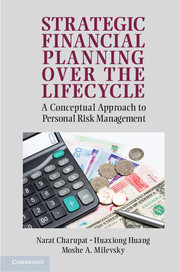Book contents
- Frontmatter
- Contents
- Acknowledgments
- 1 Introduction and Motivation
- 2 Mathematical Preliminaries – Working with Interest Rates
- 3 Personal Balance Sheet and Human Capital
- 4 Consumption Smoothing and Optimal Savings
- 5 Debts, Loans, and Mortgages [Canadian Content]
- 6 Personal Income Taxes [Canadian Content]
- 7 Risk, Utility, and Insurance
- 8 Mortality Risk and Life Insurance
- 9 Investment and Diversification
- 10 The Mathematics of Portfolio Diversification
- 11 Housing Decisions
- 12 Pensions and Retirement [Canadian Content]
- 13 Advanced Material: Part I. Continuous Time and the Calculus of Variations
- 14 Advanced Material: Part II. Stochastic Optimal Control and the HJB Equation
- 15 Concluding Thoughts and Next Steps
- Bibliography
- Index
10 - The Mathematics of Portfolio Diversification
Published online by Cambridge University Press: 05 June 2012
- Frontmatter
- Contents
- Acknowledgments
- 1 Introduction and Motivation
- 2 Mathematical Preliminaries – Working with Interest Rates
- 3 Personal Balance Sheet and Human Capital
- 4 Consumption Smoothing and Optimal Savings
- 5 Debts, Loans, and Mortgages [Canadian Content]
- 6 Personal Income Taxes [Canadian Content]
- 7 Risk, Utility, and Insurance
- 8 Mortality Risk and Life Insurance
- 9 Investment and Diversification
- 10 The Mathematics of Portfolio Diversification
- 11 Housing Decisions
- 12 Pensions and Retirement [Canadian Content]
- 13 Advanced Material: Part I. Continuous Time and the Calculus of Variations
- 14 Advanced Material: Part II. Stochastic Optimal Control and the HJB Equation
- 15 Concluding Thoughts and Next Steps
- Bibliography
- Index
Summary
Learning Objectives
In this chapter, you will formally learn the concept of diversification. In the process, you will become mindful of investment-performance claims and the roles of chance in obtaining above-average returns. You will also learn how you can construct an investment portfolio that is optimal for you given your risk preference and risk/return trade-off.
Impressive Investment Performance: Real or Fake
In the mid-1980s, a clever investment broker at a large American brokerage firm (in its Baltimore, Maryland branch) devised the following strategy in publishing his newsletters. He obtained a list of 2,000 high-net-worth individuals from a local golf club. In early January, he sent a letter to 1,000 of them (chosen at random) suggesting that they buy (i.e., long) soybean futures contracts. At the same time, he sent a different letter to the other 1,000, suggesting that they sell (i.e., short) soybean futures. By late January, soybean futures price dropped by about 10%, and so anyone in the second group who took his advice earned 10% in one month.
In early February, he sent follow-up letters to 500 of the “winners” (i.e., those who were told to short soybean futures contracts), advising them to buy German Deutschmark futures (at the time, Germany had not yet adopted the euro as their currency). The other 500 “winners” were sent a letter advising them to short Deutschmark futures. It turned out that the Deutschmark went up by 5% in February.
- Type
- Chapter
- Information
- Strategic Financial Planning over the LifecycleA Conceptual Approach to Personal Risk Management, pp. 204 - 223Publisher: Cambridge University PressPrint publication year: 2012

